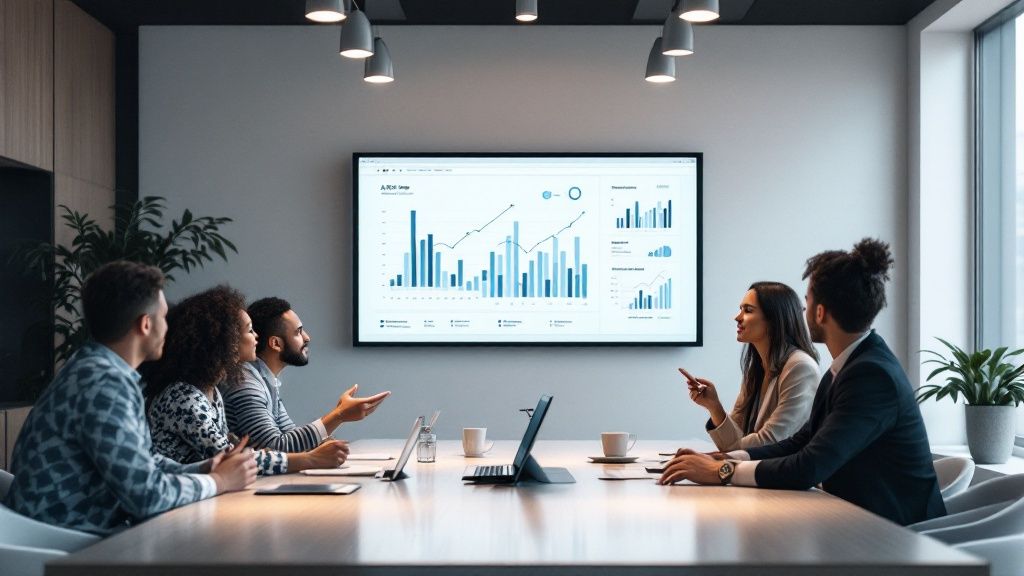Navigating Today's Event Landscape

The way people attend events has fundamentally changed. Strategies that once guaranteed a packed house might now fall flat. Attendees are more discerning, carefully choosing where to invest their time and resources. This means event organizers need to adapt their approach to boost attendance.
Understanding the Shift in Attendee Expectations
Traditional methods like mass emails and generic advertising are losing their impact. Attendees now prioritize personalized experiences and meaningful interactions. They seek value, whether it's through networking, skill development, or inspiring speakers. This calls for a more focused strategy in both promotion and experience design.
Think about the growing popularity of niche events. These focused gatherings often see greater engagement and attendance than larger, broader events. Why? Because they cater to a specific, highly motivated audience. This highlights the importance of understanding your target audience and designing the entire event around their needs.
The rise of hybrid events also reflects a demand for flexibility and accessibility. Combining in-person and virtual components allows for broader participation, reduces travel costs, and offers options for those unable to attend physically. In 2024, hybrid event popularity increased by 20%, demonstrating the industry's move towards adaptable formats. More statistics on this trend can be found here: https://swoogo.events/blog/event-industry-statistics/
Embracing Technology to Enhance the Event Experience
Technology is integral to how people experience events. Integrated event apps, for example, can streamline the attendee journey with personalized schedules and real-time updates. However, poorly designed apps or complicated registration systems can create barriers. User-friendly platforms are crucial for encouraging attendance. A good app acts as a virtual guide, while a confusing one acts as a deterrent.
Successful organizers use technology not just for logistics, but also to foster connections and create interactive experiences. Live Q&A sessions, virtual networking lounges, and interactive polls enhance attendee engagement and boost overall attendance. This focus on engagement sets successful events apart in today's competitive market.
Crafting Experiences Worth Attending

Simply providing information isn't enough to attract attendees in today's event landscape. People are looking for experiences, not just lectures. To boost your event attendance, you need to understand what truly motivates people to register and, more importantly, show up. Analyzing successful events and understanding their strategies is a great starting point.
Designing for Engagement and Interaction
Prioritizing the attendee experience is paramount for successful events. This means thinking beyond the basics like comfortable seating and good food. Focus on incorporating interactive elements, networking opportunities, and engaging sessions that build a sense of community.
Interactive workshops or Q&A sessions are a fantastic way to encourage active participation. When attendees feel invested, they're more likely to remember and value the event.
Consider adding unexpected elements that surprise and delight. This might be a unique performance, a personalized gift, or access to an exclusive networking event. These small touches can elevate the perceived value and generate positive word-of-mouth.
The Power of FOMO and Exclusivity
FOMO, or the fear of missing out, is a powerful psychological driver. Creating a sense of urgency and exclusivity around your event can significantly impact registration numbers. Limited-time ticket offers, early bird discounts, and exclusive access to particular sessions or speakers can all fuel this FOMO.
These tactics encourage early registrations and enhance the perceived value of your event. However, be mindful of overusing these strategies, as it can come across as manipulative.
The desire for transformative experiences is a major factor driving event attendance. Attendees are increasingly seeking events that offer fresh perspectives and meaningful connections. They're even prepared to spend more for these opportunities. In fact, a remarkable 78% of Gen Z and Millennials indicated they were willing to pay a premium for transformational events in 2023. You can learn more about this trend on the Eventbrite blog. This shift emphasizes the importance of creating events that resonate deeply with your audience.
Building Anticipation and Excitement
The event experience begins long before the event itself. Pre-event engagement is vital for building excitement and anticipation. Consider sending personalized emails, offering behind-the-scenes glimpses on social media platforms like Instagram, or hosting pre-event webinars and Q&A sessions with speakers.
This fosters a connection with attendees and reinforces the value proposition of your event. To understand how pre-event engagement drives attendance, let's look at the following table:
To illustrate how different event elements contribute to attendance, we've created a comparison table. It outlines the various ways traditional and experience-driven approaches impact attendance figures.
Event Elements That Drive Attendance
| Event Element | Traditional Approach | Experience-Driven Approach | Attendance Impact |
|---|---|---|---|
| Marketing | Generic advertising, mass emails | Targeted campaigns, personalized communication | Increased engagement and conversion rates |
| Content | Standard presentations, lectures | Interactive workshops, hands-on activities | Higher attendee satisfaction and knowledge retention |
| Networking | Basic breaks, informal gatherings | Structured networking sessions, facilitated connections | More meaningful interactions, stronger business relationships |
| Engagement | Passive listening | Active participation, Q&A sessions, polls | Increased attendee involvement and enthusiasm |
| FOMO & Exclusivity | Limited use | Strategic implementation of limited-time offers, exclusive access | Higher perceived value, early registrations |
As you can see, experience-driven approaches consistently yield better attendance outcomes. By focusing on creating memorable experiences, you not only boost attendance but also cultivate a loyal following for future events.
By focusing on creating engaging experiences and building genuine excitement, you can significantly increase event attendance. The key is to shift from simply delivering information to providing a truly valuable and enriching experience that leaves a lasting impression.
Digital Marketing Strategies That Fill Seats

Successfully increasing event attendance hinges on strategic digital marketing. It's more than just posting on social media; it's about truly understanding your target audience and connecting with them on the right platforms. This section explores proven digital marketing tactics to drive registrations and fill those empty seats.
Targeted Campaigns for Maximum Impact
Effective digital marketing begins with identifying the right audience. Targeting focuses your efforts on those most likely to attend. This could involve segmenting your audience by demographics, interests, or past behavior. For instance, if your event is a marketing conference, targeting professionals on LinkedIn with marketing-related job titles could be highly effective.
Timing is also crucial. Launching too early risks people forgetting your event. Starting too late doesn't give potential attendees enough time to plan. A phased approach, with early announcements building momentum as the event approaches, often works best.
Crafting Compelling Messaging
Your marketing message must clearly communicate the event's value. What will attendees gain? Highlight the key benefits, whether they're networking opportunities, insights from industry experts, or skill development.
Addressing potential hesitations is equally important. Showcasing testimonials from past attendees, offering flexible ticket options, or highlighting safety measures can build trust and encourage registrations. Proactively addressing concerns can make a real difference. For more tips, check out this article: How to master engaging email campaigns.
Remarketing to Capture Lost Opportunities
Not everyone who visits your event page registers immediately. Remarketing re-engages those who showed initial interest but didn't complete registration. This might involve targeted ads on social media or personalized email reminders.
Think of it as a gentle nudge, reminding them of the value they're missing. By staying top-of-mind, you can recapture lost opportunities and boost registration numbers. In today's busy world, this can be especially effective.
Measuring What Matters: Metrics for Success
Tracking the right metrics is essential. While vanity metrics like website visits and social media likes offer some insights, they don't tell the whole story. Focus on conversion rates, such as the percentage of website visitors who register.
By analyzing these key metrics, you can pinpoint what's working and what isn't. This data-driven approach lets you refine strategies, optimize campaigns, and ultimately, increase event attendance. Continuously evaluating your approach and adjusting based on the data is key to achieving your event goals.
Converting Interest Into Confirmed Registrations

Turning initial interest into actual event registrations is a crucial step in boosting attendance. Many potential attendees express interest but never complete the registration process. This section explores effective methods to convert that initial spark of interest into confirmed attendees, focusing on psychology, pricing strategies, and efficient follow-up.
Understanding the Psychology of Registration
Potential attendees may be interested in your event but hesitate to commit. Understanding their hesitation is key to increasing registrations. Cognitive friction, a complex or confusing registration process, can be a major deterrent. Simplify your registration form by minimizing required fields and consider offering social media login options like those available with Eventbrite.
Another key factor is risk aversion. Attendees want to know their investment is worthwhile. Clearly articulate the event's value proposition—the benefits they'll gain by attending. Strong testimonials, detailed session descriptions, and information about networking opportunities can build trust and encourage registration.
Pricing Strategies for Early Commitment
Pricing significantly influences registration decisions. It's not just about offering the lowest price, but using strategic pricing to encourage early registrations. Early bird discounts are an effective way to reward early commitment and create a sense of urgency.
Consider offering tiered pricing with different levels of access and benefits. This caters to various budgets and increases the perceived value of higher-priced tickets.
Follow-Up Systems for Abandoned Registrations
Many potential attendees start the registration process but abandon it before completion. An effective follow-up system can recapture these lost opportunities. Automated email reminders can nudge those who didn't complete registration, reminding them of the event's value and offering assistance if they experienced difficulties.
Personalizing emails by referencing specific sessions or topics they showed interest in can significantly improve their effectiveness. Studies show that a well-executed follow-up system can recover up to 40% of abandoned registrations. For more information, check out this article on personalized event emails.
A/B Testing for Continuous Improvement
Continuous testing and optimization are essential for maximizing conversions. A/B testing lets you experiment with different versions of your registration page, form fields, and calls to action. This data-driven approach identifies what resonates best with your target audience. Testing elements like button colors, headline text, or testimonial placement can reveal which variations drive the most registrations.
To help visualize how you can track and improve your registration process, take a look at the table below:
Registration Process Optimization Metrics
Key metrics to track in your registration process and how they impact overall event attendance
| Metric | Industry Benchmark | Improvement Tactics | Attendance Impact |
|---|---|---|---|
| Abandoned Registration Rate | 20-30% | Automated email reminders, personalized follow-up, simplified registration process | Reducing this rate directly increases confirmed registrations |
| Conversion Rate (Interest to Registration) | Varies greatly by industry and event type | Clear value proposition, compelling calls to action, streamlined registration | Higher conversion rates lead to increased attendance |
| Time to Complete Registration | Aim for under 2 minutes | Minimize required fields, offer social login options | Shorter registration times reduce friction and increase completion rates |
By tracking these key metrics and implementing the suggested improvement tactics, you can significantly boost your event attendance.
By understanding the psychology of registration, using strategic pricing, implementing effective follow-up, and continuously testing your approach, you can significantly improve your conversion rates. Make the registration process smooth, valuable, and appealing to maximize event attendance.
Mastering the Hybrid Attendance Model
Hybrid events offer a powerful way to boost attendance when planned strategically. By blending in-person and virtual components, you can reach a broader audience and overcome geographical barriers. This approach, however, demands careful planning and execution. Through discussions with successful event organizers, we've uncovered key strategies for thriving hybrid events.
Creating Engaging Experiences Across Attendance Modes
One of the biggest hurdles with hybrid events is creating equally compelling experiences for both in-person and virtual attendees. Simply streaming the in-person event isn't enough. The virtual experience needs its own unique interactive elements to be truly engaging.
Dedicated Virtual Content: Design elements specifically for online attendees. Think virtual networking lounges, interactive Q&A sessions, and exclusive online-only content. This makes virtual participants feel valued and actively involved, not just passive viewers.
Interactive Technology: Leverage interactive platforms like Zoom that facilitate real-time communication between both attendee groups. Live polls, chat features, and virtual breakout rooms can bridge the physical and digital divide.
Two-Way Interaction: Ensure seamless communication between in-person and virtual audiences. Assign moderators to field questions from online attendees and weave their contributions into the overall event flow.
These strategies prevent virtual attendees from feeling like an afterthought and ensure a rich, engaging experience.
Pricing Strategies for Hybrid Events
Pricing is crucial for hybrid events. The model should encourage participation in both formats without undermining in-person attendance. A poorly designed pricing strategy can devalue the in-person experience or make the virtual option seem too expensive.
Tiered Pricing: Offer different ticket tiers with varying levels of access. A basic virtual ticket might offer access to live-streamed sessions, while a premium virtual ticket includes exclusive content and networking. In-person tickets could offer added benefits like meals and in-person networking.
Bundle Deals: Encourage combined attendance with discounted packages for both in-person and virtual components. This attracts those who desire the full experience but can only attend physically for part of the event.
The aim is to balance maximizing registration and revenue while offering value to all attendees.
Maximizing Engagement for Both Audiences
Engagement is key to a successful hybrid event. Different tactics are needed to keep both audiences actively involved and invested.
Gamification: Use gamification elements such as points, badges, and leaderboards to encourage participation in both online and offline activities. This adds a fun, competitive element and promotes interaction.
Personalized Content: Tailor content and communications to each audience segment. Use data and analytics tools like Google Analytics to understand their interests and preferences, delivering relevant information and targeted offers.
Post-Event Engagement: Extend the experience beyond the final session. Provide access to recordings, resources, and online communities to continue the conversation and nurture lasting connections.
This ensures all participants, regardless of attendance mode, stay engaged and receive lasting value. By creating engaging experiences, using smart pricing, and employing targeted engagement tactics, you can maximize your hybrid event’s potential and significantly increase attendance.
Building a Community That Drives Attendance
Increasing event attendance isn't solely about the event itself; it's about cultivating a thriving community around it. The most successful events have transitioned from isolated gatherings into year-round communities, fostering connections that make registration a natural progression. This approach transforms the event from a one-time transaction into an ongoing relationship.
Fostering Meaningful Connections Year-Round
Maintaining engagement between events is vital for building a loyal audience. This bridges the gap and keeps your audience connected and invested. Think of your community like a garden – it needs consistent nurturing to flourish.
Regular Communication: Consistent, valuable communication keeps your audience engaged. This could include newsletters with industry insights, blog posts featuring speaker interviews, or social media updates showcasing community members.
Exclusive Content: Offering exclusive content to community members increases their sense of belonging. This could include early access to speaker announcements, webinars with industry experts, or downloadable resources related to past event themes.
Interactive Opportunities: Facilitate interactions between members. Online forums, Facebook groups, or virtual networking events provide platforms for connection and discussion, strengthening community bonds. This transforms passive attendees into active participants.
These strategies create a sense of belonging and shared interest, making event registration a natural extension of community membership.
Empowering Attendees as Registration Drivers
Turning your attendees into advocates is a powerful strategy for boosting attendance. People trust recommendations from their peers. Word-of-mouth marketing, amplified by enthusiastic attendees, becomes a highly effective tool.
Ambassador Programs: Formalize this approach with ambassador programs. Offer incentives like discounted tickets or exclusive access for referrals. This motivates existing members to spread the word about your event and its value.
Social Media Engagement: Encourage attendees to share their event experiences on social media. Create a unique event hashtag to track and amplify these conversations. User-generated content builds social proof and encourages registrations from their networks.
Community Spotlights: Showcase active community members and their contributions. This recognizes their involvement and inspires others to participate. Highlighting individual stories adds a human touch and reinforces the community spirit.
By empowering your attendees, you create a self-sustaining growth engine fueled by genuine enthusiasm and word-of-mouth marketing. You might be interested in: How to master customer engagement strategies.
Leveraging Community-Building Platforms
Choosing the right platform is essential for effective community building. The platform acts as the central hub, facilitating connection and communication. Different platforms offer various features, catering to diverse community needs.
Dedicated Event Platforms: Event management platforms often include built-in community features like forums and networking tools. These integrated solutions streamline communication and keep all event-related activity centralized.
Social Media Groups: Leveraging existing social media platforms like Facebook groups can be a cost-effective way to build community. This taps into existing networks and facilitates easy sharing and interaction. However, be mindful of platform limitations and data privacy.
Dedicated Community Platforms: Specialized platforms like Mighty Networks offer robust features for building and managing online communities, including membership management, content delivery, and event integration. These purpose-built platforms provide greater control and customization.
Choosing the right platform depends on your specific needs, budget, and community size. Careful consideration of these factors is crucial for success.
By fostering year-round engagement, empowering attendees, and leveraging appropriate platforms, you can build a thriving community that consistently drives event attendance. This creates a loyal audience, generates organic growth, and transforms your event from a one-time experience into a valuable, ongoing relationship.
Want to personalize your event communications and boost engagement even further? OKZest helps you create unique, personalized images for your event marketing materials, emails, and social media posts. Learn more about how OKZest can enhance your event marketing strategy and increase attendance.